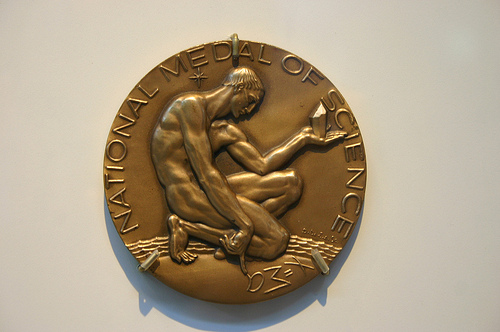USC Professor To Receive National Medal of Science
Comments (1)

(Ryan Somma/Creative Commons)
Dr. Golomb is the Andrew and Erna Viterbi Chair in Communications for USC Viterbi. Golomb, who will be 81 years old in May, will travel to Washington, D.C. to receive his award on a date that has yet to be announced.
According to the White House, “The National Medal of Science was created by statute in 1959 and is administered for the White House by the National Science Foundation. Awarded annually, the Medal recognizes individuals who have made outstanding contributions to science and engineering. A committee of Presidential appointees selects nominees on the basis of their extraordinary knowledge in and contributions to chemistry, engineering, computing, mathematics, or the biological, behavioral/social, and physical sciences.”
Dr. Golomb started at USC in 1963 and earned the title of University Professor in 1993. Dr. Golomb also holds the title of Distinguished Professor. Before coming to USC, the Harvard Graduate School Alumnus worked for the Jet Propulsion Laboratory (JPL). He holds a “joint appointment” in the two schools at USC. "[M]y primary engineering area is communication technology…lodged in the systems division of the electrical engineering department,” Dr. Golomb said in a Monday interview.
“I started in JPL in 1956 before the space program started and initially," he said. "I was hired to work on secure guidance for army missiles. That was what was supporting JPL at the time.” He continued with, “…I did quite a bit of work…in practice of secure communications…then when the Russians launched the first Sputnik on October 4, 1957, we were given the assignment, along with the Army Ballistic Missile Command, which supported JPL almost entirely at that time, and the group headed by Wernher von Braun…also supported by the Army Ballistic Missile Command, to see how rapidly we could launch a U.S. satellite into Earth orbit. And from 80 days from the time we were authorized to start until our first launch… this was a four-stage rocket…it worked on the first try.”
Golomb reflected on the accomplishment by saying, “…even looking back on it, it’s hard to believe that that happened.” The successful launch occurred on January 31, 1958.
I asked him, “How does it feel to be looking and seeing that some of these satellites are going to be soon exiting the solar system?” Dr. Golomb responded, “Well…the path that I got…when JPL was…reorganized…we were reassigned to be a large part of the support system for NASA [in 1958], so it was basically my group that did all of the initial design of space communications for satellites and planetary probes and we did the communications for the first lunar probes, for the first Mars probe…we got all of these things started…the work we did in our group laid the foundation…for all of the subsequent work that has been done in space communications…”
Dr. Golomb continued on about his work. “…the work that I had been doing on...shift register sequences, where JPL was originally interested in their possible use in secure communication...I showed…they also had use in a variety of ways of space communication, including the first successful radar bounce from another planet. We…had the first successful radar detection of the planet Venus…that was critical because we were gonna be launching a Mariner Space Probe to the vicinity of Venus and if we hadn’t done that experiment and had only relied on what was assumed to be the distance from the Earth to Venus, we would have missed the planet by a few hundred thousand miles.”
This experiment “…refined…the astronomical unit, the basic scale factor for the solar system…the basic distance between the Earth and the sun. And it turned out that the value that the astronomy community had been using was off by a part in a thousand...” These sequences have many modern uses as well, such as in GPS devices and cell phones.
During his early years at USC, Dr. Golomb wrote a paper on a specific class of codes for data compression, now known as "Golomb codes," and JPL is now using these codes on all of the Mars rovers for sending high-speed data from Mars back to Earth. Dr. Golomb proved his Harvard mathematics professors wrong because what he learned then could be used in the real world, contrary to what the professors told their students.
When asked, “How does it feel to be a recipient, from the president himself, of the National Medal of Science?” Dr. Golomb responded, “Well, you know, I think it’s generally true…that people who are sincerely interested in their scientific research are not, at the time, paying much attention to these honors and awards that generally come pretty late in your career anyway, but certainly this is an extremely distinguished award…it never crossed my mind that I would be a candidate for it, quite frankly…” He added, “…I certainly would never consider turning it down…”
Dr. Golomb believes the primary reason he is a recipient of the award is because of his work on shift register sequences.



